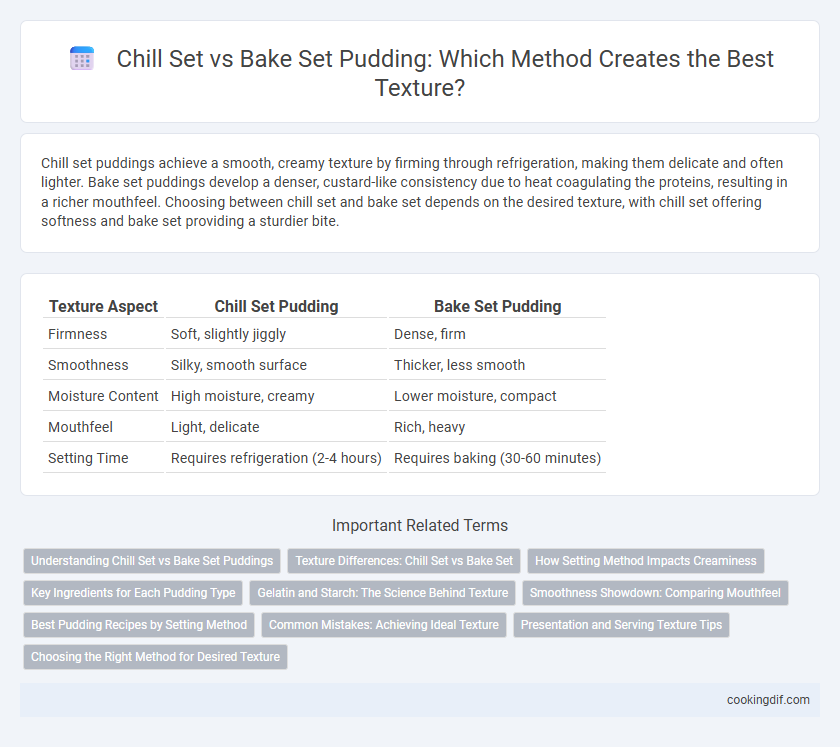Chill set puddings achieve a smooth, creamy texture by firming through refrigeration, making them delicate and often lighter. Bake set puddings develop a denser, custard-like consistency due to heat coagulating the proteins, resulting in a richer mouthfeel. Choosing between chill set and bake set depends on the desired texture, with chill set offering softness and bake set providing a sturdier bite.
Table of Comparison
| Texture Aspect | Chill Set Pudding | Bake Set Pudding |
|---|---|---|
| Firmness | Soft, slightly jiggly | Dense, firm |
| Smoothness | Silky, smooth surface | Thicker, less smooth |
| Moisture Content | High moisture, creamy | Lower moisture, compact |
| Mouthfeel | Light, delicate | Rich, heavy |
| Setting Time | Requires refrigeration (2-4 hours) | Requires baking (30-60 minutes) |
Understanding Chill Set vs Bake Set Puddings
Chill set puddings achieve a smooth, creamy texture by thickening in the refrigerator, relying on gelatin or starch to set without heat. Bake set puddings develop a firmer, custard-like consistency through baking, which coagulates proteins and creates a denser texture. Understanding the differences in setting methods helps optimize pudding texture based on desired firmness and mouthfeel.
Texture Differences: Chill Set vs Bake Set
Chill set puddings achieve a smooth, creamy texture through cooling and thickening agents like gelatin or cornstarch, resulting in a soft, delicate mouthfeel. Bake set puddings develop a firmer, custard-like consistency due to egg coagulation during baking, providing a richer, denser texture. The choice between chill set and bake set significantly impacts the pudding's overall mouthfeel and structural stability.
How Setting Method Impacts Creaminess
Chill set puddings develop a smoother, creamier texture as the cold temperature allows gradual thickening, preserving moisture and preventing curdling. Bake set puddings undergo heat-induced gelatinization and protein coagulation, resulting in a firmer, custard-like texture with less creaminess. The method of setting directly influences the pudding's mouthfeel, with chill set providing a richer, silkier experience compared to the denser structure of bake set puddings.
Key Ingredients for Each Pudding Type
Chill set puddings, such as traditional gelatins or custards, rely on gelatin or agar-agar and milk or cream to create a smooth, creamy texture that firms as it cools. Bake set puddings incorporate eggs as a key ingredient, providing structure and a denser, creamier texture through the coagulation of proteins during baking. Key ingredients like cornstarch or flour are often added in chill set puddings for thickening, while bake set puddings depend mainly on egg proteins and dairy to achieve their signature custard-like consistency.
Gelatin and Starch: The Science Behind Texture
Gelatin creates a smooth, delicate pudding texture by forming a soft gel that melts pleasantly in the mouth, ideal for chill set preparations. Starch, contrastingly, thickens through gelatinization when heated, producing a firm yet creamy texture typical of bake set puddings. Understanding the molecular interactions of gelatin and starch helps optimize pudding consistency, balancing creaminess and structural integrity.
Smoothness Showdown: Comparing Mouthfeel
Chill set pudding achieves a silky, creamy texture by carefully cooling the mixture, which enhances smoothness and provides a melt-in-the-mouth experience. Bake set pudding relies on heat to firm up the custard, resulting in a denser texture with a slightly grainier mouthfeel compared to the chilled version. The chill set is favored for its consistently smooth and luscious finish, making it ideal for desserts that emphasize delicate textures.
Best Pudding Recipes by Setting Method
Chill set puddings yield a creamy, smooth texture ideal for delicate flavors and quick preparation, while bake set puddings develop a denser, custard-like consistency with rich, caramelized notes. Recipes such as classic chocolate pudding and vanilla cream benefit from chilling to maintain softness, whereas baked puddings like bread pudding and flan require heat to set and deepen flavor complexity. Choosing the setting method depends on the desired pudding texture and intensity, influencing the overall taste experience.
Common Mistakes: Achieving Ideal Texture
Chilling pudding sets a smooth, creamy texture by allowing gradual thickening, while baking creates a firmer, custard-like consistency through heat-induced protein coagulation. Common mistakes include overbaking, which causes dryness, or insufficient chilling, resulting in a runny texture. Understanding the protein and starch interactions helps in achieving the ideal pudding texture tailored to either a chill or bake set.
Presentation and Serving Texture Tips
Chill set puddings offer a smooth, creamy texture ideal for elegant presentations in glassware or molded shapes, enhancing visual appeal with clean edges and glossy surfaces. Bake set puddings develop a firmer, custard-like consistency suitable for slicing and plating, providing stability for layered desserts or toppings. For serving, chill set puddings benefit from gentle scooping to maintain shape, while bake set puddings hold well when cut, enabling precise portion control and decorative garnishing.
Choosing the Right Method for Desired Texture
Chilling pudding yields a smooth, creamy texture with a soft, set consistency ideal for delicate desserts, while baking develops a firmer, custard-like texture with a slight golden crust, enhancing richness and structure. Selecting the chilling method preserves moisture and delicate flavors, perfect for light, refreshing treats. Choosing the bake set suits recipes requiring stability and a denser mouthfeel, such as traditional baked custards or tarts.
Chill set vs bake set for texture Infographic

 cookingdif.com
cookingdif.com